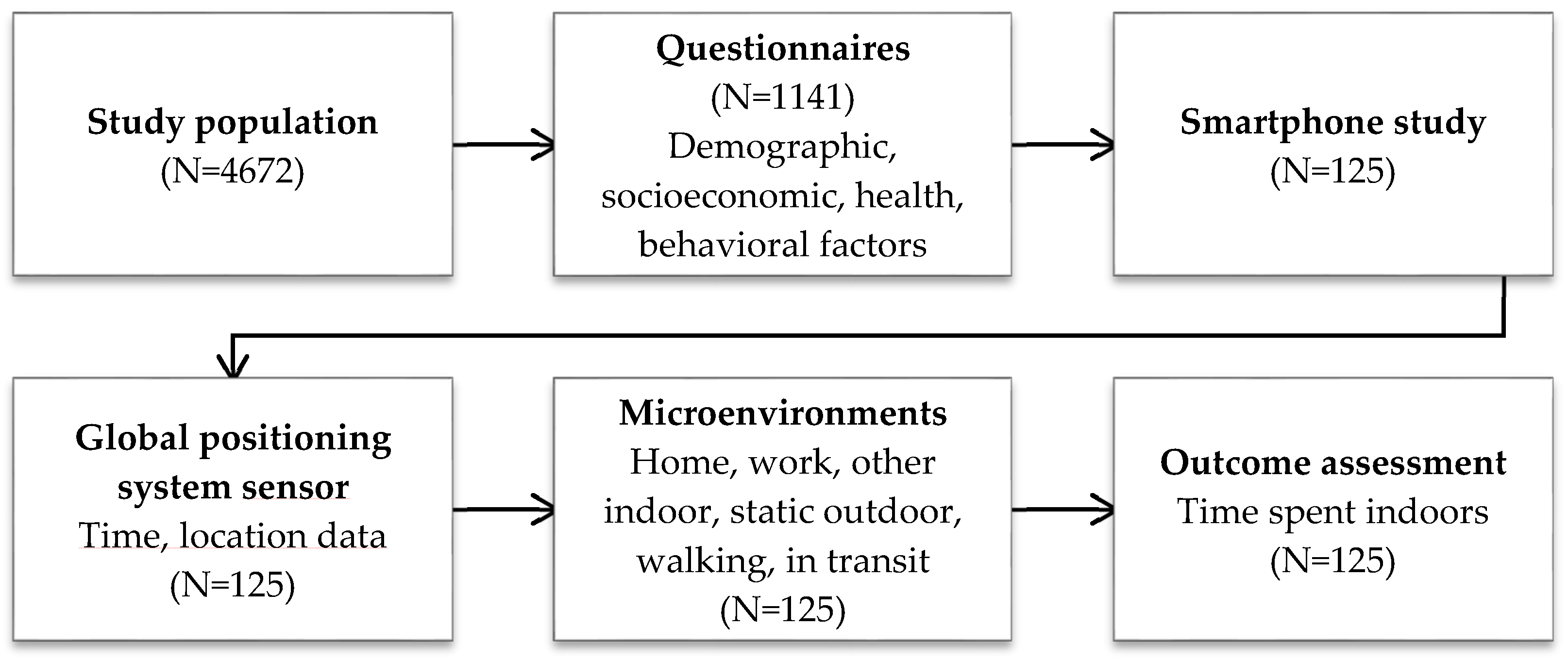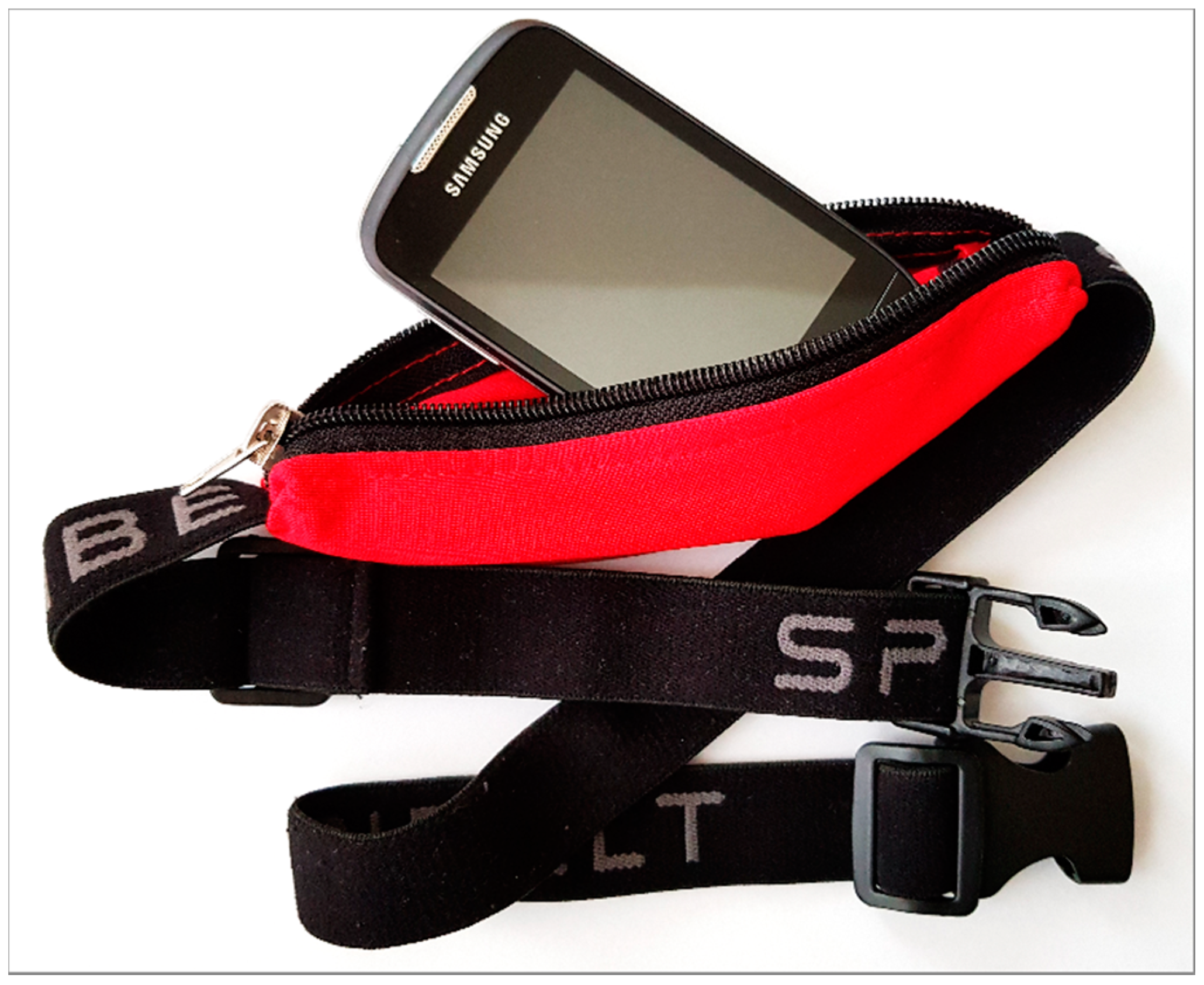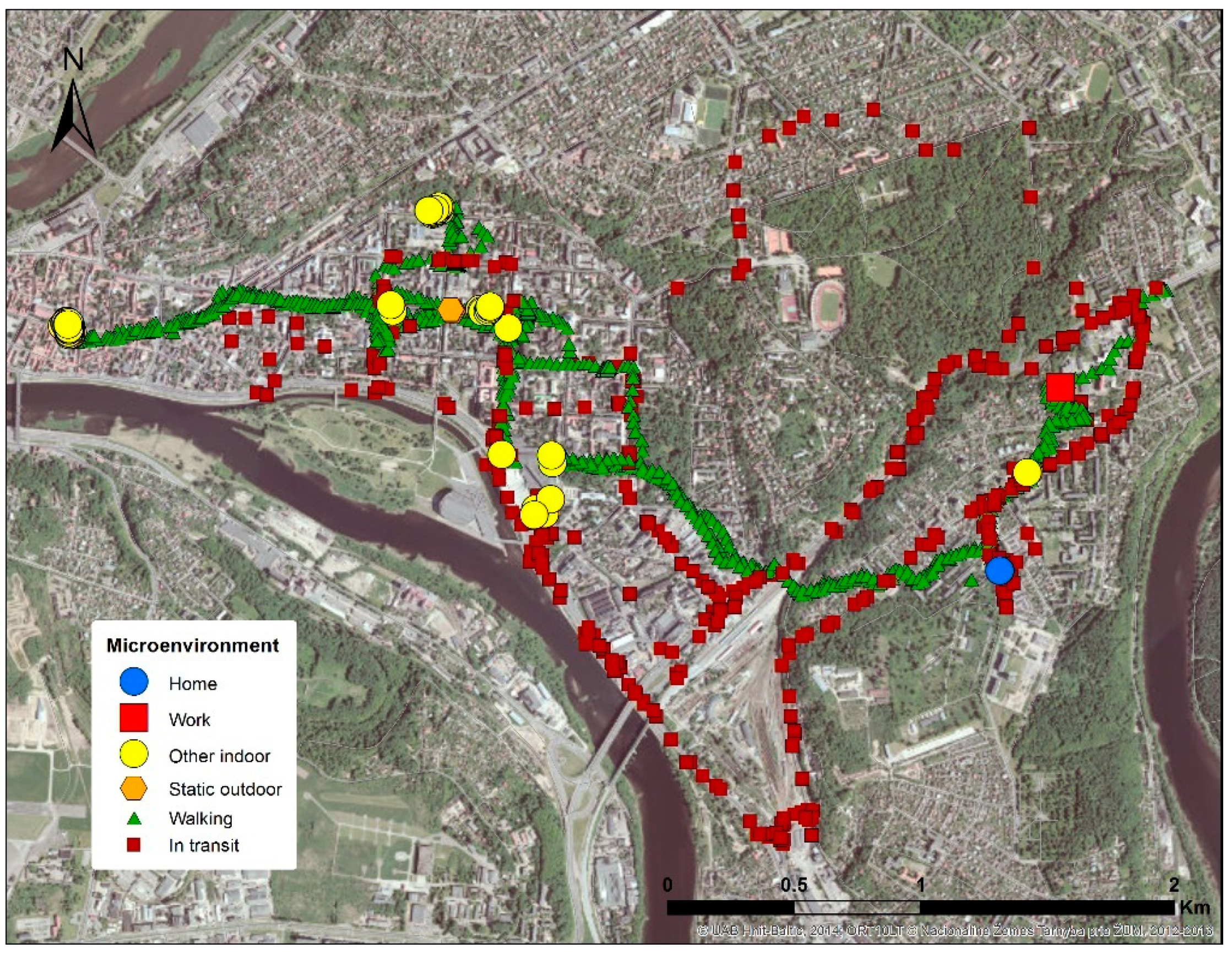Effects of Individual and Environmental Factors on GPS-Based Time Allocation in Urban Microenvironments Using GIS
Abstract
1. Introduction
2. Materials and Methods
2.1. Selection of Study Population and Study Design
2.2. Time-Activity Pattern Assessment
2.3. The Assessment of Individual Characteristics and Other Factors among Adults
2.4. Statistical Analysis
3. Results
3.1. Characteristics of Study Participants
3.2. Time-Activity Patterns among the Urban Adult Population
4. Discussion
Author Contributions
Funding
Conflicts of Interest
References
- Nieuwenhuijsen, M.; Paustenbach, D.; Duarte-Davidson, R. New developments in exposure assessment: The impact on the practice of health risk assessment and epidemiological studies. Environ. Int. 2006, 32, 996–1009. [Google Scholar] [CrossRef] [PubMed]
- Semple, S. Assessing occupational and environmental exposure. Occup. Med. 2005, 55, 419–424. [Google Scholar] [CrossRef] [PubMed]
- Steinle, S.; Reis, S.; Sabel, C.E.; Semple, S.; Twigg, M.M.; Braban, C.F.; Leeson, S.R.; Heal, M.R.; Harrison, D.; Lin, C.; et al. Personal exposure monitoring of PM2.5 in indoor and outdoor microenvironments. Sci. Total Environ. 2015, 508, 383–394. [Google Scholar] [CrossRef] [PubMed]
- Buonanno, G.; Stabile, L.; Morawska, L. Personal exposure to ultrafine particles: The influence of time-activity patterns. Sci. Total Environ. 2014, 468–469, 903–907. [Google Scholar] [CrossRef] [PubMed]
- Dewulf, B.; Neutens, T.; Lefebvre, W.; Seynaeve, G.; Vanpoucke, C.; Beckx, C.; Van de Weghe, N. Dynamic assessment of exposure to air pollution using mobile phone data. Int. J. Health Geogr. 2016, 15, 1–14. [Google Scholar] [CrossRef] [PubMed]
- Yang, W.; Lee, K.; Yoon, C.; Yu, S.; Park, K.; Choi, W. Determinants of residential indoor and transportation activity times in Korea. J. Expo. Sci. Environ. Epidemiol. 2011, 21, 310–316. [Google Scholar] [CrossRef] [PubMed]
- Spalt, E.W.; Curl, C.L.; Allen, R.W.; Cohen, M.; Williams, K.; Hirsch, J.A.; Adar, S.D.; Kaufman, J.D. Factors influencing time-location patterns and their impact on estimates of exposure: The Multi-Ethnic Study of Atherosclerosis and Air Pollution (MESA Air). J. Expo. Sci. Environ. Epidemiol. 2016, 26, 341–348. [Google Scholar] [CrossRef] [PubMed]
- Matz, C.J.; Stieb, D.M.; Brion, O. Urban-rural differences in daily time-activity patterns, occupational activity and housing characteristics. Environ. Health 2015, 14, 88. [Google Scholar] [CrossRef] [PubMed]
- Nethery, E.; Mallach, G.; Rainham, D.; Goldberg, M.S.; Wheeler, A.J. Using Global Positioning Systems (GPS) and temperature data to generate time-activity classifications for estimating personal exposure in air monitoring studies: An automated method. Environ. Health 2014, 13, 33. [Google Scholar] [CrossRef] [PubMed]
- Nieuwenhuijsen, M.J. Urban and transport planning, environmental exposures and health-new concepts, methods and tools to improve health in cities. Environ. Health 2016, 15, 38. [Google Scholar] [CrossRef] [PubMed]
- De Nazelle, A.; Seto, E.; Donaire-Gonzalez, D.; Mendez, M.; Matamala, J.; Nieuwenhuijsen, M.J.; Jerrett, M. Improving estimates of air pollution exposure through ubiquitous sensing technologies. Environ. Pollut. 2013, 176, 92–99. [Google Scholar] [CrossRef] [PubMed]
- Breen, M.S.; Long, T.C.; Schultz, B.D.; Crooks, J.; Breen, M.; Langstaff, J.E.; Isaacs, K.K.; Tan, Y.M.; Williams, R.W.; Cao, Y.; et al. GPS-based microenvironment tracker (MicroTrac) model to estimate time-location of individuals for air pollution exposure assessments: Model evaluation in central North Carolina. J. Expo. Sci. Environ. Epidemiol. 2014, 24, 412–420. [Google Scholar] [CrossRef] [PubMed]
- Kelly, P.; Krenn, P.; Titze, S.; Stopher, P.; Foster, C. Quantifying the Difference Between Self-Reported and Global Positioning Systems-Measured Journey Durations: A Systematic Review. Transp. Rev. 2013, 33, 443–459. [Google Scholar] [CrossRef]
- Houston, D.; Luong, T.T.; Boarnet, M.G. Tracking daily travel; Assessing discrepancies between GPS-derived and self-reported travel patterns. Transp. Res. C Emerg. Technol. 2014, 48, 97–108. [Google Scholar] [CrossRef]
- Ribeiro, M.D.; Larrañaga, A.M.; Arellana, J.; Cybis, H.B.B. Influence of GPS and Self-reported Data in Travel Demand Models. Procedia Soc. Behav. Sci. 2014, 162, 467–476. [Google Scholar] [CrossRef]
- Duan, N. Models for human exposure to air pollution. Environ. Int. 1982, 8, 305–309. [Google Scholar] [CrossRef]
- Lim, S.; Salmond, J.A.; Dirks, K.N. Influence of Differing Microenvironments on Personal Carbon Monoxide Exposure in Auckland, New Zealand. Open Atmos. Sci. J. 2015, 9, 1–8. [Google Scholar] [CrossRef]
- Rabinovitch, N.; Adams, C.D.; Strand, M.; Koehler, K.; Volckens, J. Within-microenvironment exposure to particulate matter and health effects in children with asthma: A pilot study utilizing real-time personal monitoring with GPS interface. Environ. Health. 2016, 15, 96. [Google Scholar] [CrossRef] [PubMed]
- Sarigiannis, D.A. Combined or multiple exposure to health stressors in indoor built environments. In Proceedings of the An Evidence-based Review Prepared for the WHO Training Workshop “Multiple Environmental Exposures and Risks”, Bonn, Germany, 16–18 October 2013; World Health Organization Regional Office for Europe: Copenhagen, Denmark, 2014; p. 82. [Google Scholar]
- Schweizer, C.; Edwards, R.D.; Bayer-Oglesby, L.; Gauderman, W.J.; Ilacqua, V.; Jantunen, M.J.; Lai, H.K.; Nieuwenhuijsen, M.; Künzli, N. Indoor time–microenvironment–activity patterns in seven regions of Europe. J. Expo. Sci. Environ. Epidemiol. 2006, 17, 170–181. [Google Scholar] [CrossRef] [PubMed]
- Kim, T.; Lee, K.; Yang, W.; Yu, S.D. A new analytical method for the classification of time-location data obtained from the global positioning system (GPS). J. Environ. Monit. 2012, 14, 2270–2274. [Google Scholar] [CrossRef] [PubMed]
- Wu, J.; Jiang, C.; Houston, D.; Baker, D.; Delfino, R. Automated time activity classification based on global positioning system (GPS) tracking data. Environ. Health 2011, 10, 101. [Google Scholar] [CrossRef] [PubMed]
- Groenwold, R.H.H.; Klungel, O.H.; Grobbee, D.E.; Hoes, A.W. Selection of confounding variables should not be based on observed associations with exposure. Eur. J. Epidemiol. 2011, 26, 589–593. [Google Scholar] [CrossRef] [PubMed]
- Lee, P.H. Is a Cutoff of 10% Appropriate for the Change-in-Estimate Criterion of Confounder Identification? J. Epidemiol. 2014, 24, 161–167. [Google Scholar] [CrossRef] [PubMed]
- Lee, P.H. Should we adjust for a confounder if empirical and theoretical criteria yield contradictory results? A simulation study. Sci Rep. 2014, 4, 6085. [Google Scholar] [CrossRef] [PubMed]
- Klepeis, N.E.; Nelson, W.C.; Ott, W.R.; Robinson, J.P.; Tsang, A.M.; Switzer, P.; Behar, J.V.; Hern, S.C.; Engelmann, W.H. The National Human Activity Pattern Survey (NHAPS): A resource for assessing exposure to environmental pollutants. J. Expo. Sci. Environ. Epidemiol. 2001, 11, 231–252. [Google Scholar] [CrossRef] [PubMed]
- Matz, C.J.; Stieb, D.M.; Davis, K.; Egyed, M.; Rose, A.; Chou, B.; Brion, O. Effects of Age, Season, Gender and Urban-Rural Status on Time-Activity: Canadian Human Activity Pattern Survey 2 (CHAPS 2). Int. J. Environ. Res. Public Health 2014, 11, 2108–2124. [Google Scholar] [CrossRef] [PubMed]
- Spinazze, A.; Cattaneo, A.; Peruzzo, C.; Cavallo, D.M. Modeling Population Exposure to Ultrafine Particles in a Major Italian Urban Area. Int. J. Environ. Res. Public Health 2014, 11, 10641–10662. [Google Scholar] [CrossRef] [PubMed]



| Characteristic | Number | Percentage |
|---|---|---|
| Age | ||
| <45 | 47 | 37.6 |
| 45–64 | 54 | 43.2 |
| 65+ | 24 | 19.2 |
| Gender | ||
| Male | 55 | 44.0 |
| Female | 70 | 56.0 |
| Marital status | ||
| Married | 73 | 58.4 |
| Divorced | 17 | 13.6 |
| Single | 27 | 21.6 |
| Widowed | 8 | 6.4 |
| Education level | ||
| Secondary school | 35 | 28.0 |
| University degree | 90 | 72.0 |
| Occupational status | ||
| Working full-time | 47 | 37.6 |
| Working part-time, student | 36 | 28.8 |
| Unemployed, retired, or other | 42 | 33.6 |
| Income | ||
| Lower than average | 52 | 41.6 |
| Higher than average | 73 | 58.4 |
| Ethnic group | ||
| Lithuanian | 121 | 96.8 |
| Other | 4 | 3.2 |
| Body mass index | ||
| Normal weight (<24.9) | 66 | 54.1 |
| Overweight (25.0–29.9) | 36 | 29.5 |
| Obese (>30.0) | 20 | 16.4 |
| Chronic disease | ||
| No | 58 | 46.4 |
| Yes | 67 | 53.6 |
| Variable | Home | Work | Other Indoor | Outdoor | Walking | In Transit |
|---|---|---|---|---|---|---|
| Gender | ||||||
| Men | 68.1 | 17.2 | 7.0 | 1.7 | 2.4 | 3.6 |
| Women | 70.9 | 14.2 | 8.4 | 1.4 | 2.6 | 2.5 |
| p between groups | 0.843 | 0.145 | 0.456 | 0.046 * | 0.363 | 0.001 * |
| Age | ||||||
| <45 | 71.9 | 12.1 | 8.4 | 1.8 | 2.8 | 3.0 |
| 45–64 | 65.8 | 19.7 | 7.7 | 1.2 | 2.2 | 3.4 |
| 65+ | 77.3 | 8.7 | 6.9 | 2.0 | 2.8 | 2.3 |
| p between groups | 0.012 * | 0.000 * | 0.609 | 0.472 | 0.049 * | 0.075 |
| Occupational status | ||||||
| Working full-time | 64.3 | 20.2 | 8.9 | 1.0 | 2.1 | 3.3 |
| Working part-time | 74.8 | 10.1 | 7.4 | 1.9 | 2.9 | 3.0 |
| Unemployed, retired, others | 83.4 | 0.0 | 8.4 | 2.1 | 3.0 | 3.1 |
| p between groups | 0.000 * | 0.000 * | 0.898 | 0.009 * | 0.037 * | 0.709 |
| BMI | ||||||
| <30 | 70.3 | 14.8 | 7.7 | 1.6 | 2.7 | 3.1 |
| ≥30 | 67.7 | 17.5 | 8.2 | 1.5 | 2.1 | 3.0 |
| p between groups | 0.443 | 0.786 | 0.743 | 0.942 | 0.296 | 0.982 |
| Chronic diseases | ||||||
| No | 70.1 | 14.5 | 8.5 | 1.6 | 2.5 | 2.8 |
| Yes | 69.2 | 16.5 | 7.1 | 1.5 | 2.5 | 3.2 |
| p between groups | 0.433 | 0.208 | 0.516 | 0.827 | 0.890 | 0.191 |
| Walking in leisure time | ||||||
| Yes | 70.8 | 14.2 | 7.7 | 1.6 | 2.8 | 2.9 |
| No | 67.6 | 18.3 | 7.4 | 1.4 | 1.9 | 3.5 |
| p between groups | 0.988 | 0.035 * | 0.863 | 0.335 | 0.004 * | 0.432 |
| Bicycle use | ||||||
| Often | 66.7 | 17.0 | 7.4 | 2.0 | 2.7 | 4.2 |
| Seldom | 70.6 | 14.9 | 7.9 | 1.4 | 2.5 | 2.7 |
| p between groups | 0.642 | 0.471 | 0.936 | 0.076 | 0.784 | 0.000 * |
| Car disposal | ||||||
| No | 70.6 | 13.5 | 8.9 | 1.4 | 3.0 | 2.5 |
| Yes | 69.5 | 16.2 | 7.2 | 1.6 | 2.2 | 3.3 |
| p between groups | 0.295 | 0.273 | 0.399 | 0.929 | 0.003 * | 0.119 |
| Variable | Home | Work | Other Indoor | Outdoor | Walking | In Transit |
|---|---|---|---|---|---|---|
| Residential greenness | ||||||
| Very/fairly | 68.9 | 15.9 | 7.2 | 1.7 | 2.8 | 3.5 |
| Little/not at all | 70.8 | 14.7 | 8.3 | 1.5 | 2.3 | 2.6 |
| p between groups | 0.240 | 0.872 | 0.475 | 0.552 | 0.098 | 0.056 |
| Noise concentration | ||||||
| Lower than median | 74.2 | 15.0 | 8.9 | 2.1 | 2.6 | 3.6 |
| Higher than median | 70.4 | 16.6 | 7.2 | 1.1 | 2.6 | 2.7 |
| p between groups | 0.162 | 0.463 | 0.197 | 0.009 * | 0.880 | 0.032 * |
| Day type | ||||||
| Working day | 66.2 | 18.9 | 7.5 | 1.8 | 2.4 | 3.2 |
| Weekend | 67.3 | 16.5 | 9.2 | 1.6 | 2.6 | 2.8 |
| p between groups | 0.000 * | 0.423 | 0.083 | 0.334 | 0.421 | 0.551 |
| Variable | Crude OR | 95% CI | Adjusted † OR | 95% CI |
|---|---|---|---|---|
| Gender | ||||
| Men | 1 | 1 | ||
| Women | 1.44 | 0.70–2.94 | 1.11 | 0.47–2.58 |
| Age | ||||
| <45 | 1 | 1 | ||
| 45–64 | 0.89 | 0.41–1.95 | 0.88 | 0.39–2.01 |
| 65+ | 1.15 | 0.42–3.18 | 1.20 | 0.41–3.51 |
| Occupational status | ||||
| Working full-time | 1 | 1 | ||
| Working part-time | 0.65 | 0.27–1.55 | 0.79 | 0.30–2.06 |
| Unemployed, retired, others | 0.81 | 0.35–1.88 | 0.89 | 0.36–2.20 |
| BMI | ||||
| <30 | 1 | 1 | ||
| ≥30 | 0.80 | 0.31–2.10 | 0.60 | 0.19–1.84 |
| Chronic disease | ||||
| No | 1 | 1 | ||
| Yes | 0.61 | 0.30–1.25 | 0.38 | 0.14–1.04 |
| Walking in leisure time | ||||
| Yes | 1 | 1 | ||
| No | 2.14 | 0.94–4.88 | 2.77 * | 1.09–7.05 |
| Bicycle use | ||||
| Often | 1 | 1 | ||
| Seldom | 3.32 * | 1.20–9.18 | 3.86 * | 1.28–11.66 |
| Car disposal | ||||
| No | 1 | 1 | ||
| Yes | 0.96 | 0.46–2.00 | 1.36 | 0.59–3.16 |
| Residential greenness | ||||
| Very/fairly | 1 | 1 | ||
| Little/not at all | 2.80 * | 1.35–5.82 | 2.84 * | 1.33–6.05 |
| Noise concentration | ||||
| Lower than median | 1 | 1 | ||
| Higher than median | 1.97 | 0.97–4.01 | 1.76 | 0.84–3.72 |
© 2018 by the authors. Licensee MDPI, Basel, Switzerland. This article is an open access article distributed under the terms and conditions of the Creative Commons Attribution (CC BY) license (http://creativecommons.org/licenses/by/4.0/).
Share and Cite
Dėdelė, A.; Miškinytė, A.; Česnakaitė, I.; Gražulevičienė, R. Effects of Individual and Environmental Factors on GPS-Based Time Allocation in Urban Microenvironments Using GIS. Appl. Sci. 2018, 8, 2007. https://doi.org/10.3390/app8102007
Dėdelė A, Miškinytė A, Česnakaitė I, Gražulevičienė R. Effects of Individual and Environmental Factors on GPS-Based Time Allocation in Urban Microenvironments Using GIS. Applied Sciences. 2018; 8(10):2007. https://doi.org/10.3390/app8102007
Chicago/Turabian StyleDėdelė, Audrius, Auksė Miškinytė, Irma Česnakaitė, and Regina Gražulevičienė. 2018. "Effects of Individual and Environmental Factors on GPS-Based Time Allocation in Urban Microenvironments Using GIS" Applied Sciences 8, no. 10: 2007. https://doi.org/10.3390/app8102007
APA StyleDėdelė, A., Miškinytė, A., Česnakaitė, I., & Gražulevičienė, R. (2018). Effects of Individual and Environmental Factors on GPS-Based Time Allocation in Urban Microenvironments Using GIS. Applied Sciences, 8(10), 2007. https://doi.org/10.3390/app8102007





